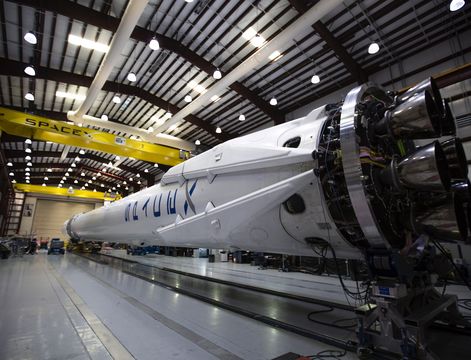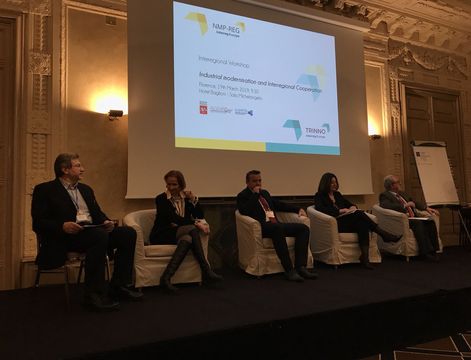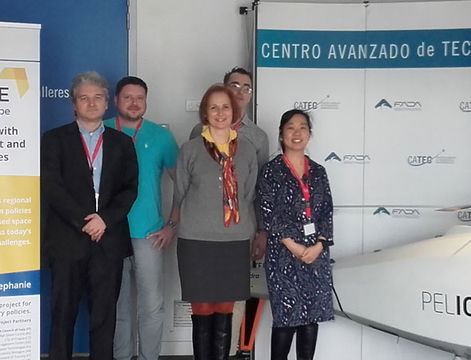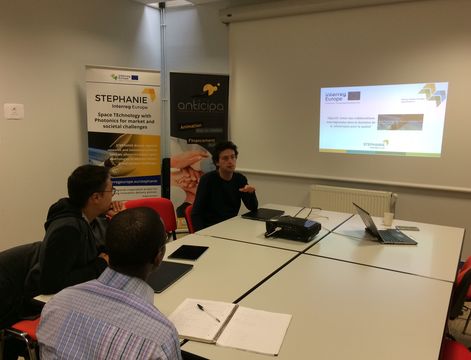
Successful in the field of key technologies
Successful in the field of key enabling technologies with STEPHANIE: Space TEchnology with PHotonics for market and societal challenges
Space technologies based on photonics are considered as one of Europe’s areas of key industrial competence. They have huge potential to address a number of today’s grand societal challenges, in particular health and wellbeing, climate action and secure societies. However, this potential will be wasted if public polciy fails to address the gap between space research and its application on the ground. A long-term challenge is to ensure that R&I investments exploit the opportunities offered by space (e.g. huge availability of data and signals) by ensuring that applications and services are produced to address societal challenges and that they reach the market.
Recognising the role played by EU regions in space policy, both in strategic development and territorial impact, STEPHANIE brings together 8 partners from 7 areas to exchange knowledge on how to ensure that policy is designed to guarantee real benefits from space technology based on photonics, particularly in space and earth observation.
Partners have recognised two pilars that their ERDF policy instruments can focus on to support this R&I delivery:
- using quadruple helix cooperation along the technological value chain at regional and interregional level;
- coordinated and simplified funding schemes for the development of marketable and society orientated products and services.
Partners and regional stakeholders cooperate over three years of interregional learning, leading to regional Action Plans that detail concrete measures for policy improvements. They continue to cooperate while implementing these measures, using interregional exchange for further stimulus and monitoring.
Policy changes will deliver long-term impact to regional competitiveness and socio-environmental well-being, thanks to collaborative innovation and innovative products addressing socio-environmental needs. They will open new markets for enterprises and improve capacity of regions to direct European space policies and strategies.
Watch the screen recording of the final event here:
€2,185,501.00
Research and innovation
The policy instrument objective is to Strengthen RTD and Innovation (Axis 1). STEPHANIE addresses priority 1b “promote innovation, RTD investments and support synergies among enterprises, RTD centres and higher education institutes. Cooperation should develop new products/services, technology transfer, social/eco/open innovation and clusters through smart specialisation, applied research and advanced manufacturing especially in KETs, including photonics.
Measures that the project hopes to address are those supporting: innovation services in companies; innovative solutions for new products/processes and industrialisation of RTD results; clusters among enterprises, RTD centres and other stakeholders; support to technological advancement through pilot lines, early product validation, large-scale demonstration.
The measures are designed to address the need to improve innovation delivery along the technological value chain. Cluster organisations and innovation services have been supported by regional policy, but more work is required. Real impact is hindered by lack of systemic cooperation among regional stakeholders, as well as concrete measures to connect R&I and applied solutions to societal/environmental challenges.
New Technology Districts should encourage collaboration among key actors, with a focus on supporting market exploitation. However, while the vision is clear, it requires practical input to make it a reality in terms of business / funding and cooperation models.
The OP PGP overall aim is to achieve the 3 aspects of growth – sustainability, smartification, inclusivity. Promoting smart growth through the achievement of specific objectives in Priority Axis 1 and 4 is at the basis of the programming document.
PA 1: Strengthening research, technological development and innovation focuses on promoting business investment in R&I, developing links and synergies between enterprises, research and development centres and the higher education sector. In particular it promotes investment in product and service development, technology transfer, social innovation, eco-innovation, public service applications, demand stimulation, networking, clusters and open innovation through smart specialisation, and supporting technological and applied research, pilot lines, early product validation actions, advanced manufacturing capabilities and first production.
PA 1 is generally focused on R&D and innovation without specific focus on space technologies. However, emerging technologies (i.e. in the space sector) have been identified in RIS3 as key priorities, which are also central to a number of Prague-based innovative companies working in applied research.
Linking ERDF funds with these new emerging enabling technologies is a now strong need for the City of Prague. Efforts towards this directions are supported by new initiatives in cooperation with the EU Space Agency (i.e. creation of an innovation centre for space technologies application).
NRW's innovation strategy combines the state's research, lead market and technology transfer strategy in a common approach and focuses on selected fields. The idea is to focus in NRW on those growth areas that are of particular relevance to the state's economy and population and in which both the companies and research institutions exhibit obvious strengths and potential.
A major goal of the innovation strategy is the dissemination of knowledge and experiences. The transfer strategy systematically promotes the exchange of experience and wants to make lessons learned for start-ups (start-up initiative), companies (patent validation, consulting and innovation voucher) and for the people (communication) available.
R,D&I must be dedicated to sustainable solutions to societal challenges: climate protection/acclimation; resource-efficiency/raw materials; safe/healthy food; safe, clean, efficient energy; smart/ecofriendly mobility; health/well-being; safety; participation and social cohesion in course of societal and structural change.
The regional innovation strategy highlights the importance of cross-sectional key enabling technologies including photonics for all application areas and in addition, space technologies are recognised as an important area of activity for NRW's industrial sector of mechanical and plant engineering. The policy instrument underestimates the potential of photonics in space technologies for the development of products to address societal challenges.
The overall objective of Priority Axis 2 “Improve Brittany's economic performance through the support of research, innovation and enterprises” is to strengthen the competitiveness and the economic performance of Brittany.
Targeted actions clearly identify the governance of the RIS3 (Action 2.2.4) as a key element to:
- improve technology transfer between research centres and companies (Action 2.2.1), the support to emerging of both innovative industrial projects (2.2.2) and collaborative industrial projects (2.2.3);
- Reinforce the competitiveness of Breton R&D in the European Research Area (ERA);
- Improve the innovation capacity of Breton SMEs;
- Increase the production potential of Breton SMEs.
However, the selected policy instrument does not currently focus on the specific funding of photonics. This is unfortunate, given that a significant number of local players have interest to develop their activities in this domain. Indeed, there is much research and innovation potential to build on. Furthermore, the potential of photonics in space technologies for the development of products to address societal challenges should also be addressed by the policy. There is currently limited focus in the policy instrument on how to support a link up between KETs and, for example, environmental or health problems.
The policy instrument is the England OP 2014-20 / Priority Axis 1: Promoting Research and Innovation (North East). Within Priority 1b several measures are relevant to STEPHANIE.
This measure focuses on developing links and synergies between enterprises, research and development centres and the Higher Education sector, in particular promoting investment in product and service development, technology transfer, social innovation, eco-innovation, public service applications, demand stimulation, networking, clusters and open innovation through smart specialisation. This alos supports technological and applied research, pilot lines, early product validation actions, advance manufacturing capabilities and first production, in particular in key enabling technologies (such as photonics) and diffusion of general purpose technologies. The policy also seeks to increase investment in research and innovation by SMEs, in sectors and technologies identified through smart specialisation.
The expected result is an increase in number of SMEs engaged in knowledge exchange, collaborative and contract research and innovation with research institutions, public institutions or large enterprisesto help them bring new products and processes to market. The policy instrument needs to be improved thanks to practical examples of how this can work in reality, and in an innovative sector such as space technology and photonics. The socio/eco innovation target of prodcuts should also be strengthened.
The policy instrument objective is to Strengthen RTD and Innovation (Axis 2).
STEPHANIE addresses priority 1b aiming to strengthen research, technological development and innovation by promoting R&I investments in business, developing links and synergies between businesses, research centres and the development and education sector.
Within Priority 1b measures that the project hopes to address are: Strengthening RDI capacity of research organisations in areas useful for SMEs; Increase regional innovation through increased collaboration between research centres, universities and innovative companies; Increase processes, innovative products and services through intensification of open innovation and RDI in business
The action also enables participation of Walloon stakeholders in EU programmes and initiatives. It is a key part of rooting the S3 process in the Region and connected to the issue of combining and making better use of funding.
The policy requires a clearer focus on innovation and market exploitation, and KETs (including photonics). There is a strong need to consolidate links between the scientific and economic domains, as well as strengthening collaboration among key players of the technological value chain. Actions financed in the framework of axis 2 are part of the thematic clusters policy, which is a main focus for the region. This shows how efforts in these directions are a priority for the region, though there is still much room for improvement.
Andalusian regional operational programme ERDF 2014-2020 has 10 objectives. Thematic Objective 1 (IP 1b) aims to strengthening research, technological development and innovation.
This axis, with 429.85 million (14.78%) of total budget, focuses on 2 pillars:
- investment in R&D infrastructure (97.3 million euros);
- finance for R&D projects, both in the business environment (of special importance in this context) at research level, with 332 million euros. Technology transfer from institutions to enterprises should be improved (over 52 million euros forthis priority).
The following action lines will be implemented:
• Financing R,D&I for enterprises
• Support for creation and consolidation of start-ups, encouraging creation of spin-off related to the priorities of Andalusia RIS3, enhancing the intensity of innovation and the result of innovative efforts.
• Connecting centers, infrastructure and existing facilities with the private sector.
• Consolidation of R&D activities, in private and public sectors, for developing key enabling technologies (photonics among these), improving relationship between research results and industrial impact.
The policy does not currently directly focus on quadruple helix initiatives. This is an extremely interesting concept to be integrated to the policy: collaboration is encouraged, but quadruple helix would be an important step forward in terms of supporting marketable products. The focus on societal challenges could also be reinforced.

Successful in the field of key enabling technologies with STEPHANIE: Space TEchnology with PHotonics for market and societal challenges

There were many exciting impulses at the Stephanie partner meeting.

The Interreg Europe project “STEPHANIE” was able to identify numerous potentials for raising innovation by opening up photonic technologies in space applica...

On October 20th 2021 the STEPHANIE project kicked off an additional year of exchange

We recently started a new trans-border collaboration between Wallonia and Brittany through the project CAFCA.

Setting up of a bi-regional collaboration between Wallonia and Brittany through a joint call funding innovation projects gathering partners from both regions
Tuscany: The quality of air and weather forecasts at the center of the 6th regional stakeholder group

A representative of the STEPHANIE project was invited to present the project at the TRINNO conference.

The fifth “Interregional Learning Event” of “STEPHANIE” provided a wide range of regional good practice examples and was start for the Action Plan development.

Le projet européen STEPHANIE présenté lors d’un atelier sur les technologies issues du spatial.